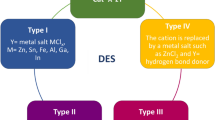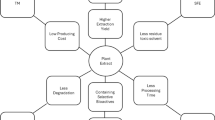Abstract
The presented paper shows the influence of temperature increase in the range typically used during antioxidant measurements (15–35 °C) on the estimation of antioxidant properties of phenolic compounds (caffeic acid, ferulic acid, gallic acid, trolox, butylhydroxyanisole, butylhydroxytoluene and 2,6-diisopropylphenol) in associating and non-associating solvents. A significant influence of temperature on the DPPH•/antioxidant reaction kinetic is observed for strongly associating solvents (e.g. methanol). This trend is less marked for non-associating solvents (e.g. dioxane, ethyl acetate). The performed experiments prove that the change of solvent structure, caused by temperature increase, influences the estimation of antioxidant properties of phenolic compounds much more than the increase of kinetic energy of reacting molecules and/or the increase of the dissociation degree of hydroxyl groups occurring in antioxidants.






Similar content being viewed by others
References
Andrè CM, Larondelle Y, Evers D (2010) Dietary antioxidants and oxidative stress from human and plant perspective: a review. Curr Nutr Food Sci 6:2–12
Arnao MB (2000) Some methological problems in the determination of antioxidant using chromogen radicals: a practical case. Trends Food Sci Technol 11:419–421
Bondet V, Brand-Williams W, Berset C (1997) Kinetics and mechanisms of antioxidant activity using the DPPH• free radical method. LWT Food Sci Technol 30:609–615
Borowski P, Jaroniec J, Janowski T, Woliński K (2003) Quantum cluster equilibrium theory of hydrogen – bonded liquids: water, methanol and ethanol. Mol Phys 101(10):1413–1421
Brand-Williams W, Cuvelier ME, Berset C (1995) Use of a free radical method to evaluate antioxidant activity. LWT Food Sci Technol 28:25–30
Brannan RG, Connolly BI, Decker EA (2001) Peroxynitrite: a potential initiator of lipid oxidation in food. Trends Food Sci Technol 12:164–173
Cosio MS, Buratti S, Mannino S, Benedetti S (2006) Use of an electrochemical method to evaluate the antioxidant activity of herb extracts from the Labiatae family. Food Chem 97:725–731
Dawidowicz AL, Olszowy M (2010) Influence of some experimental variables and matrix components in the determination of antioxidant properties by β-carotene bleaching assay: experiments with BHT used as standard antioxidant. Eur Food Res Technol 231:835–840
Dawidowicz AL, Olszowy M (2011) Antioxidant properties of BHT estimated by ABTS assay in systems differing in pH or metal ion or water concentration. Eur Food Res Technol 232:837–840
Dawidowicz AL, Wianowska D, Olszowy M (2012) On practical problems in estimation of antioxidant activity of compounds by DPPH* method. Food Chem 131:1037–1104
Eskin NAM, Robinson DS (2001) Food shelf life stability; chemical, biochemical and microbiological changes. CRC Press, Washington
Grune T, Schringarpure R, Sitte N, Davies K (2001) Age-related changes in protein oxidation and proteolysis in mammalian cells. J Gerontol 56A:B459–B467
Halliwell B, Aeschbach R, Lőliger I, Aruoma OI (1995) The characterization of antioxidants. Food Chem Toxicol 33:601–617
Huang DJ, Ou BX, Prior RL (2005) The chemistry behind antioxidant capacity assays. J Agric Food Chem 53:1841–1856
Janeiro P, Brett AMO (2004) Catechin electrochemical oxidation mechanisms. Anal Chim Acta 518:109–115
Kamlet MJ, Abboud JLM, Abraham MH, Taft RW (1983) Linear salvation energy relationships. 23. A comprehensive collection of the solvatochromic parameters, pi∗, alpha, and beta, and some methods for simplifying the generalized solvatochromic equation. J Org Chem 48:2877–2887
Karadag A, Ozcelik B, Saner S (2009) Review of methods to determine antioxidant capacities. Food Anal Methods 2:41–60
Laidler KJ (1987) Chemical kinetics, 3rd edn. Harper & How, New York
Ludwig R (1999) Quantum clusters equilibrium theory of liquids: molecular clusters and thermodynamics of liquid ethanol. Mol Phys 97:465–477
Litwinienko G, Ingold KU (2007) Solvent effects on the rates and mechanisms of the reaction of phenols with free radicals. Account Chem Res 40:222–230
Miyabe K, Isogai R (2011) Estimation of molecular diffusivity in liquid phase systems by the Wilke-Chang equation. J Chromatogr A 1218:6636–6645
Molyneux P (2004) The use of the stable free radical diphenylpicrylhydrazyl (DPPH) for estimating antioxidant activity. Songklanakarin J Sci Technol 26:211–219
Moure A, Cruz JM, Franco D, Dominguez JM, Sineiro J, Dominguez H (2001) Natural antioxidant from residual sources. Food Chem 72:145–171
Namicki M (1990) Antioxidants/antimutagens in food. Food Sci Nutr 29:273–300
Ndhlala AR, Moyo M, Staden JV (2010) Natural antioxidants: fascinating or mythical biomolecules? Molecules 15:6905–6930
Noguchi N, Niki E (2000) Phenolic antioxidants: a rationale for design and evolution of novel antioxidant drug for atherosclerosis. Free Radic Biol Med 28:1538–1546
Prior RL, Wu X, Schaich K (2005) Standardized methods for determination of antioxidant capacity and phenolics in food and dietary supplements. J Agric Food Chem 53:4290–4302
Schlesier K, Harwat M, Bohm V, Bitsch R (2002) Assessment of antioxidant activity by using different in vitro methods. Free Radic Res 36:237–242
Sen S, Chakraborty R, Sridhar C, Reddy YSR, De B (2010) Free radicals, antioxidants, diseases and phytomedicines: current status and future prospect. Int J Pharm Sci Rev Res 3:91–100
Villaňo D, Fernández- Pachoń MS, Troncoso AM, Garcia-Parrilla MC (2004) The antioxidant activity of wines determined by the ABTS •+ method: influence of sample dilution and time. Talanta 64:501–509
Yanai N, Shiotani S, Hagiwara S, Nabetani H, Nakijma M (2008) Antioxidant combination inhibits reactive oxygen species mediated damage. Biosci Biotechnol Biochem 72:3100–3106
Author information
Authors and Affiliations
Corresponding author
Rights and permissions
About this article
Cite this article
Dawidowicz, A.L., Olszowy, M. & Jóźwik-Dolęba, M. Importance of solvent association in the estimation of antioxidant properties of phenolic compounds by DPPH method. J Food Sci Technol 52, 4523–4529 (2015). https://doi.org/10.1007/s13197-014-1451-2
Revised:
Accepted:
Published:
Issue Date:
DOI: https://doi.org/10.1007/s13197-014-1451-2




